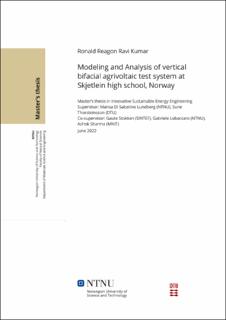| dc.description.abstract | The agriculture sector is facing three significant challenges: i) food production
must double by 2030 in order to feed an ever-growing population, ii) decrease in
the amount of arable lands and iii) accelerating climate change. Agricultural crop
is exposed to extreme climate events and lacks water due to heat stress. With
frequent drought and growing unpredictability in climate, it has become the need
of the hour to have systems running on fully-renewable energy sources, not to mention
the urgent need to preserve, rather than deplete, ever-scarcer water resources.
Systems of this nature enable us to work towards increased crop productivity by
making farmlands more resilient to climate extremities/change.
Innovative solution like agrivoltaics can address these problems. They adopt photovoltaic (
PV) technology so as to coexist with crop cultivation. Agrivoltaics are
attracting a lot of attention across the globe, especially in regions where PV power
plants and agricultural practices are common. As of this writing, there have only
been two agrivoltaic studies in continental climate zones.
Norway has been doing well in terms of its renewable energy mix by fully utilizing
its hydro energy resources. Norway was previously classified as a country with low
PV potential, but as of 2021, it has a total installed PV capacity of 216.8 MW.
Norway’s agriculture sector is doing fairly well, especially when you consider the
challenges involved: cold winters, hilly mountain areas, and high relative humidity.
The backbone of Norwegian agriculture is grasslands and livestock, i.e., grassland
covers 70% of Norwegian agricultural land
The potential usage of agrivoltaics in Norwegian conditions has not been researched
so far. This thesis aims to find a suitable modelling procedure to model
a vertical bifacial East/West oriented agrivoltaic system. This model uses a
53.3 kWp agrivoltaic system, located at Skjetlein videreg˚aende skole, Trondheim
(N63°41.06′ E10°45.39′) with ’timothy grass’ as a crop. Crop yield will be estimated
using the CATIMO crop model.
The energy analysis results agree well with the literature concerning the performance
of vertical bifacial systems in Norwegian conditions. In an agrivoltaic scenario,
vertically East/West oriented PV systems provide a homogeneous light distribution
compared to conventionally oriented South-facing PV systems. Sun hour
analysis reveals different shading patterns on crops near the edges of PV modules
compared to internal rows. Estimated land-use efficiency of agrivoltaic systems
is 79% higher than the efficiency of conventional land use, either for PV power
plants (100% energy) or for the cultivation of crops (100% crop).
Overall, the methodology developed in this thesis is an effective modelling tool
that can be used for other agrivoltaic configurations, crops, and climate zone. | |
